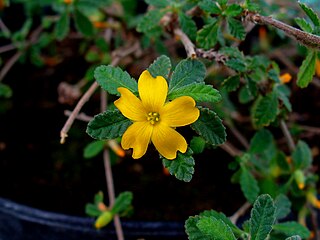
Turnera diffusa, known as damiana, is a shrub native to southern Texas in the United States, Mexico, Central America, South America, and the Caribbean. It belongs to the family Passifloraceae.

Aromatase inhibitors (AIs) are a class of drugs used in the treatment of breast cancer in postmenopausal women and in men, and gynecomastia in men. They may also be used off-label to reduce estrogen conversion when supplementing testosterone exogenously. They may also be used for chemoprevention in women at high risk for breast cancer.

Eucalyptol is a monoterpenoid colorless liquid, and a bicyclic ether. It has a fresh camphor-like odor and a spicy, cooling taste. It is insoluble in water, but miscible with organic solvents. Eucalyptol makes up about 70–90% of eucalyptus oil. Eucalyptol forms crystalline adducts with hydrohalic acids, o-cresol, resorcinol, and phosphoric acid. Formation of these adducts is useful for purification.

Chrysin, also called 5,7-dihydroxyflavone, is a flavone found in honey, propolis, the passion flowers, Passiflora caerulea and Passiflora incarnata, and in Oroxylum indicum. It is extracted from various plants, such as the blue passion flower. Following oral intake by humans, chrysin has low bioavailability and rapid excretion. It is under basic research to evaluate its safety and potential biological effects.

Phenanthrenoids are chemical compounds formed with a phenanthrene backbone. These compounds occur naturally in plants, although they can also be synthesized.

Pinobanksin is an antioxidant bioflavonoid that inhibits peroxidation of low density lipoprotein and it has electron donor properties reducing alpha-tocopherol radicals. It is present in sunflower honey.
The galanin receptor is a G protein-coupled receptor, or metabotropic receptor which binds galanin.
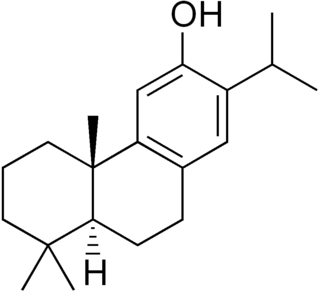
Ferruginol is a natural phenol with a terpenoid substructure. Specifically, it is a diterpene of the abietane chemical class, meaning it is characterized by three fused six-membered rings and alkyl functional groups. Ferruginol was first identified in 1939 by Brandt and Neubauer as the main component in the resin of the Miro tree and has since been isolated from other conifer species in the families Cupressaceae and Podocarpaceae. As a biomarker, the presence of ferruginol in fossils, mainly resin, is used to describe the density of these conifers in that particular biosphere throughout time.

The 5HT6 receptor is a subtype of 5HT receptor that binds the endogenous neurotransmitter serotonin (5-hydroxytryptamine, 5HT). It is a G protein-coupled receptor (GPCR) that is coupled to Gs and mediates excitatory neurotransmission. HTR6 denotes the human gene encoding for the receptor.

Metabotropic glutamate receptor 4 is a protein that in humans is encoded by the GRM4 gene.
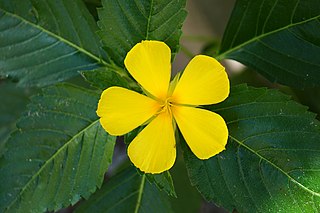
Turnera ulmifolia, the ramgoat dashalong or yellow alder, is a species of plant of family Passifloraceae, native to Mexico and the West Indies. A recent study found that yellow alder potentiated the antibiotic activity against methicillin-resistant Staphylococcus aureus (MRSA).
A xanthine oxidase inhibitor is any substance that inhibits the activity of xanthine oxidase, an enzyme involved in purine metabolism. In humans, inhibition of xanthine oxidase reduces the production of uric acid, and several medications that inhibit xanthine oxidase are indicated for treatment of hyperuricemia and related medical conditions including gout. Xanthine oxidase inhibitors are being investigated for management of reperfusion injury.

MS-245 is a tryptamine derivative used in scientific research. It acts as a selective 5-HT6 receptor antagonist with a Ki of 2.3 nM, and was derived through structure-activity relationship development of the selective 5-HT6 agonist EMDT. It has been used as a lead compound for further development of tryptamine-derived 5-HT6 antagonists. In animal studies it has been shown to boost the activity of, but not substitute for, both amphetamine and nicotine.

Galangin is a flavonol, a type of flavonoid.

Caffeic acid phenethyl ester (CAPE) is a natural phenolic chemical compound. It is the ester of caffeic acid and phenethyl alcohol.

Acacetin is a 4′-O-methylated flavone of the parent compound apigenin, found in Robinia pseudoacacia, Turnera diffusa (damiana), Betula pendula, and in the fern Asplenium normale.

8-Carboxamidocyclazocine (8-CAC) is an opioid analgesic drug related to cyclazocine, discovered by medicinal chemist Mark P. Wentland and co-workers in Cogswell Laboratory at Rensselaer Polytechnic Institute. Similarly to cyclazocine, 8-CAC acts as an agonist at both the μ- and κ-opioid receptors, but has a much longer duration of action than cyclazocine, and does not have μ antagonist activity. Unexpectedly, it was discovered that the phenolic hydroxyl group of cyclazocine could be replaced by a carboxamido group with only slight loss of potency at opioid receptors, and this discovery has subsequently been used to develop many novel opioid derivatives where the phenolic hydroxy group has been replaced by either carboxamide or a variety of larger groups. Due to their strong κ-opioid agonist activity, these drugs are not suited for use as analgesics in humans, but have instead been researched as potential drugs for the treatment of cocaine addiction.

Propolis or bee glue is a resinous mixture that honey bees produce by mixing saliva and beeswax with exudate gathered from tree buds, sap flows, or other botanical sources. It is used as a sealant for unwanted open spaces in the beehive. Propolis is used for small gaps, while gaps larger than the bee space are usually filled with burr comb. Its color varies depending on its botanical source, with dark brown as the most common. Propolis is sticky above 19 °C (66 °F), while at lower temperatures, it becomes hard and brittle.
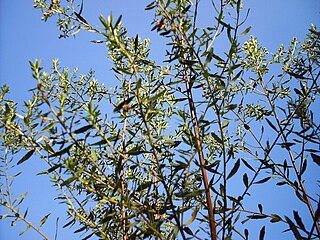
Baccharis dracunculifolia is a medical plant found in Brazil, Bolivia, Argentina, and Uruguay.
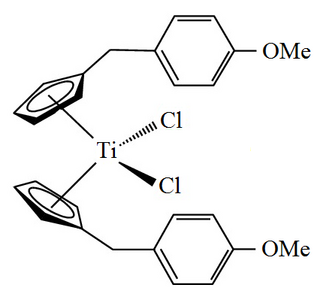
Titanocene Y also known as bis[(p-methoxybenzyl)cyclopentadienyl]titanium(IV) dichloride or dichloridobis(η5-(p-methoxybenzyl)cyclopentadienyl)titanium is an organotitanium compound that has been investigated for use as an anticancer drug.


















